Electric heating in a private home: a review of the best types of electric heating systems
The choice of a heating system is a key issue, the solution of which determines the comfort of living and the safety of the owner’s financial resources.When considering various options, it is worth paying attention to electric heating in a private home, assessing its pros and cons in order to compare it with other proposals.
Modern systems powered by electricity are very diverse. Not all of them consume excessive amounts of electricity. Let's look at each of them in detail.
The content of the article:
Why choose electric heating?
It is generally accepted that heating a home with systems powered by electricity is too expensive. Therefore, their advantages are somehow not taken into account.
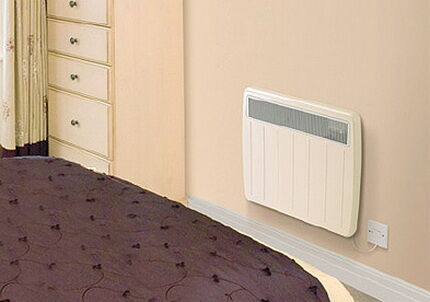
This is fundamentally wrong, because electrical systems have many significant advantages that distinguish them from other types of heating:
- Safety. The equipment does not work with open flames or explosive substances, like other heating devices. High-quality wiring provides reliable protection against possible fire.
- Easy to operate and maintain. Automatic systems regulate the operation of equipment, which requires minimal human intervention. There are no elements that require regular replacement or cleaning.
- Complete environmental safety. During operation, the system does not emit toxic substances, so it can be installed in any room.
- No need to store fuel reserves. Therefore, a special room for storing flammable materials is not required.
- Compactness. Most of the equipment is small in size. The varied design of the devices makes it easy to choose a model for any interior style.
- Low cost. Compared to other types of heating devices, the price of such equipment is much lower.
Among the significant disadvantages of electrical systems, in addition to the fairly high cost of electricity, in fairness, it should be noted that the equipment is completely energy dependent.
This means that if there is a power outage, all appliances will stop working, which will be especially noticeable in areas with frequent outages. In addition, for uninterrupted operation of the equipment, you will need a powerful electrical network, which is not available everywhere.
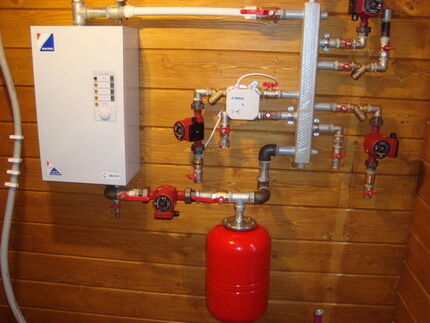
Water heating with electric boiler
It is a standard system with a coolant fluid circulating through the heating circuit. Its main difference is that the coolant is heated only through the use of an electric boiler.
Because of this, such a system will have some features. First of all, it can only be of a closed type and must be equipped membrane expansion tank.
Otherwise, it will not be possible to avoid uneven heating of the premises, losses in the speed and power of heat exchange, which will lead to excessive consumption of electricity and, accordingly, unjustified expenses. For the same reasons, it is not recommended to install a system with natural circulation.
The best option is forced circulation of the coolant, which will make it possible to save energy as much as possible. To work with such a heating system, three types of electric boilers can be used. Let's look at the advantages and disadvantages of each of them.
Boilers with heating elements type heaters
Heating elements are installed in each of these devices. These are heating elements that operate on the principle of resistive heating of a conductor through which an electric current passes.
Due to the fact that they have to work in liquid, the devices are additionally protected in the form of a waterproof case and reliable insulation. Therefore, the power of the heating elements is slightly reduced.
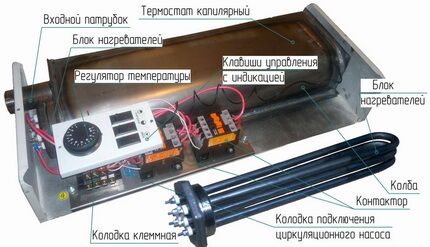
As a result, the efficiency of each such heater is no more than 80.Therefore, in order for boilers of this type to heat the coolant to the required temperature, it is necessary to either increase the number heating elements, or install heaters of higher power.
In any case, energy losses are inevitable, which negatively affects the efficiency of devices of this type. Most often, manufacturers install 3-4 heating elements in one boiler. There are different modes of operation of the device. Depending on this, all heating elements, only one of them, or groups of elements can be switched on.
Power electric boilers The heating element type varies from 3 to 50 kW. The most powerful models are designed for connection to a three-phase network, while less powerful ones can operate from a single-phase network.
The layout of the heating elements in the device may be different, which affects their appearance. They can be made in the form of cylinders with heating elements “hidden” inside and a control unit located in a separate housing, or have the usual rectangular shape with controls located on the housing.
The cost of boilers of this type is very low, which is due to their inefficiency.
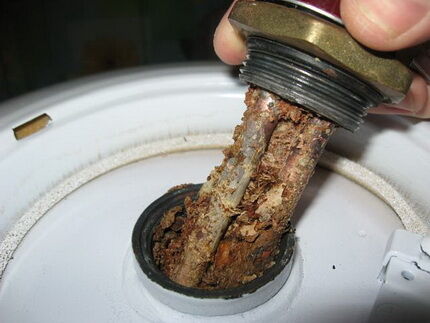
Heating element devices also have disadvantages. First of all, this is the short “life” of the heating element. During operation of the device, it becomes covered with salt deposits and fails.
Therefore regular change of heating elements such a device is necessary. Another “minus” is that when starting equipment with a small amount of coolant or in its absence, the heaters fail.
Boilers with electrode operating principle
The operating principle of the device is fundamentally different from heating element models.To generate heat, frequency oscillations in an alternating network are used, which, in turn, cause oscillations of the ions in the electrolyte, which leads to its rapid heating.
The boiler itself is a housing with two electrodes immersed in a coolant, the role of which is played by a conductive liquid or electrolyte. Most often, antifreeze of one brand or another is used for these purposes.
Electrode devices are distinguished by their compactness and low weight, while their heating power is high. Such boilers can be installed in groups, starting one or more devices at once as needed. Another advantage of electrode equipment is its almost complete insensitivity to voltage changes in the network.
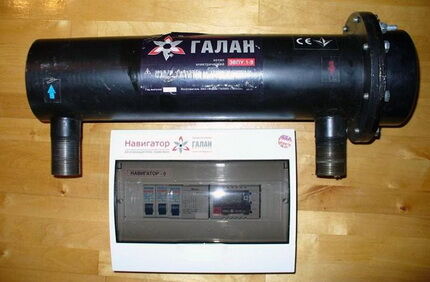
The safe range for them is 15-20%, which is quite a lot. However, the stability of the AC frequency is very important for devices. Electrode boilers are completely fireproof, since such a device cannot overheat, and if there is no coolant, it simply will not turn on.
The device heats up very quickly. In terms of efficiency, it is 20% superior to its heating element counterpart, that is, its efficiency is about 98%. At the same time, its productivity can be increased.
This is achieved by tying the device with metal pipes. Thus, the ionization zone of the coolant expands significantly, which gives the effect of increasing productivity. The cost of electrode boilers is low. Therefore, when such equipment first appeared, it was considered almost an ideal heating device.
However, during operation, shortcomings also emerged. First of all, this is not a stable power of the device.
It very much depends on the chemical composition of the conductive liquid and its temperature, since even with small deviations the electrical conductivity of the solution changes, which leads to changes in the heating intensity. In addition, the electrode system is very difficult to automatically control and adjust.
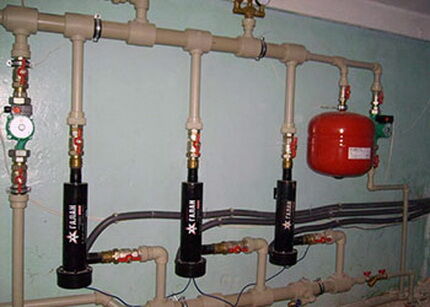
For boilers of this type, cleanliness of the composition is extremely important. coolant. If the proportions of the solution are not observed or if it is contaminated, all the advantages of such a system are lost. Therefore, at least once a year it is necessary to correct the chemical composition of the electrolyte.
At the same frequency, you will need to clean the heat exchanger and the entire heating system from salt deposits, which will accumulate quite quickly. A prerequisite for connecting an electric heating system to an electrode-type house is the presence of a grounding loop.
Thus, despite the fact that such heating devices are more economical than their heating element counterparts, they are not in particular demand. A fairly large number of disadvantages make their use for heating a private home not entirely convenient.
Induction type heating boilers
These are the most advanced representatives of electric heating systems. These devices are based on the principle of electromagnetic induction. Everything happens as follows. An electric current is passed through the primary winding, located in the core of the device.
It induces voltage in the secondary winding located closer to the device body. It is a labyrinthine pipe system through which coolant passes.
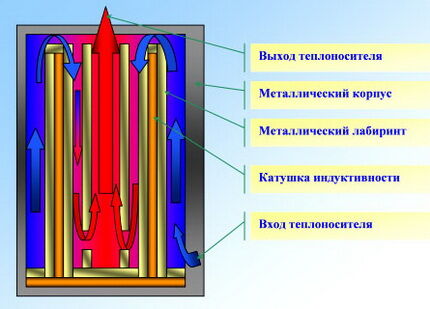
When the secondary circuit closes, resistive heating of the conductor and, accordingly, the coolant occurs. There are no energy losses, so the efficiency of such a system is almost 100%.
Heating of the liquid occurs very quickly and evenly. Induction boilers are very economical. This figure increases even more due to the self-induction of the system, which is associated with additional reactive power.
It is generated by currents passing through a secondary closed circuit. In this case, the values of the resulting additional power are quite large. A type of inductive boiler operates somewhat differently - a vortex induction heater or VIN.
Its primary winding receives voltage, which is first converted to high frequency. Thus, the electromagnetic field strength increases sharply.
What gives the same rapid increase in current generated by this field? The peculiarity of the VIN boiler is that it does not have a secondary winding. Instead, all metal surfaces of the equipment are used.
They are specially made from materials with pronounced ferromagnetic properties. The appearance of eddy currents leads to magnetization reversal, which causes strong and almost instantaneous heating of ferromagnetic alloys.
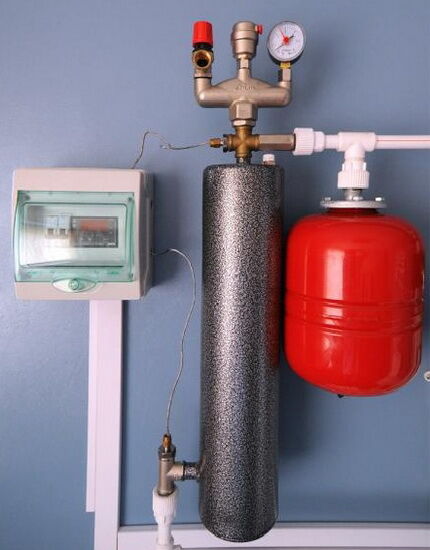
Consequently, almost all massive elements of the housing are involved in the heat exchange process, which makes it possible to obtain a very high efficiency, approaching 100%. Induction boilers of both types are distinguished by their significant weight and relatively small size.They can be installed one at a time or in groups, the latter providing significant advantages when organizing the heating of a building.
You can make an induction-type boiler for arranging a summer house or a small private house with your own hands. Induction Boiler Assembly Guide, given in the article we recommend, will help you choose the best option and correctly build the unit.
The advantages of induction boilers include fast, almost instantaneous heating. The equipment is easy to adjust, so automatic control units are mounted on it, providing precise settings. In terms of electrical and fire safety, these devices are the most favorable when compared with analogues of other types.
The high efficiency of induction devices does not decrease even after long-term operation. This is due to the fact that salt deposits or scale do not accumulate inside the device. They are removed by high-frequency microvibrations that accompany the operation of the equipment. For the same reason, there are no special requirements for the chemical composition of the coolant. Boilers are insensitive to it.
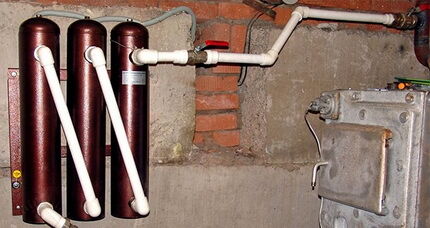
Another advantage is the long service life of induction boilers. Without exaggeration, it can be calculated in tens of years. This is explained by the fact that the equipment simply does not have vulnerable nodes. There is no contact between the electrical part of the device and the coolant.
Problems can only arise with welds, which usually last a very long time. The main advantage of this type of equipment is its cost-effectiveness.
Practice shows that it allows you to save up to 40% of electricity compared to its heating element and electrode counterparts. Among the disadvantages, it is worth noting the slight vibration noise that boilers emit during operation.
It is massive, which requires attention during installation, especially if the device is mounted on the wall. Another disadvantage is the fairly high cost of induction devices.
Infrared heating equipment
To heat your country house with electricity, you can use modern infrared heating systems. For their operation, the principle of wave energy transfer over a certain distance is used.
Everything happens as follows. The emitter converts electrical energy into an infrared wave and transmits it. The waves move until they hit any opaque surface.
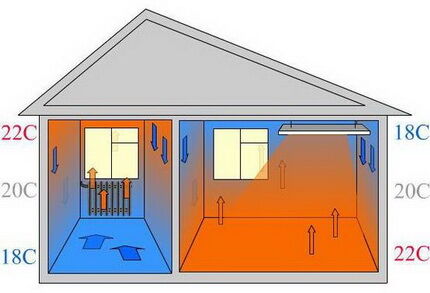
Here they are converted into thermal energy, heating the body that they meet on their way. An object heated in this way, be it large furniture, a floor or a wall, begins to release heat into the atmosphere, thereby heating the air in the room.
In this way, the room is heated as uniformly as possible, and the temperatures are distributed in the most comfortable way for a person. At the same time, there is practically no energy loss, which determines the high efficiency of infrared heaters.
They are available in various versions. Especially popular is the special infrared film with carbon emitters sealed inside it. It is used to install a heated floor system and can be used on the ceiling and walls.The film is covered with any finishing material, which does not affect its properties.
The thickness of the infrared film is small, it is invisible under any coating. The system is moisture resistant and is not afraid of dynamic loads. Subject to dismantling and subsequent use.
You can find it on sale infrared heaters, there are both regular ones and those made in the form of plates of various sizes. They are also designed for mounting on walls or ceilings. True, in this case we are talking more about additional heating than about the main one.
In terms of efficiency, infrared equipment is superior to all known electric heating systems. This is explained by the fact that it manages to heat the room very quickly, after which the automatic control unit periodically turns the device on/off, maintaining the desired temperature.
The disadvantages of infrared systems include the strict directionality of heating. The device heats only the area located in front of it. Therefore, for example, infrared film is laid around the entire perimeter of the floor or ceiling.
Another disadvantage is the fairly high cost of such equipment, especially if you need to purchase material for installing a heated floor or PLEN system for the ceiling. However, we must admit that such investments pay off fairly quickly.

Heating electric convectors
The operation of these devices is similar to the operation of heating radiators. They also heat up and transfer heat to the air around them. The difference is that there is no coolant in convectors. Therefore, inlet/outlet pipe systems are not needed.
Instead, heating elements are located inside the device, which heat its surface. The lower part of the device is intended for intake of cold air.
It penetrates inside the convector through a special mesh. Heated by the heating element, the air rises higher and exits through the upper grille.
During operation of the heating device, a stable upward flow of warm air is created, which quickly warms the room. To regulate the heating temperature, the equipment is equipped with a thermostat, and an automatic control unit can be installed.
Manufacturers produce a wide range of devices of varying power and design. For rooms with high humidity, you can purchase devices with special protection. Will introduce you to the criteria for choosing an electric convector next article, which we recommend reading.
Convectors are extremely easy to use and safe. The heating element of the device is located inside its body, but the outer panel heats up very little, so it is impossible to get burned on it.
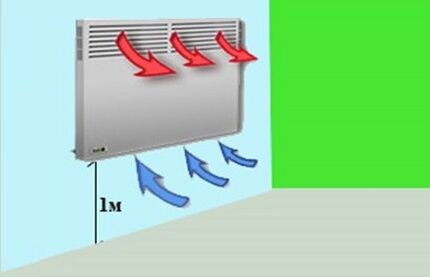
Heating devices are silent, so they do not create any inconvenience. Various variations of convectors are produced, including mobile portable models. There are devices designed for floor mounting. They are installed under windows, in front of doors and in other similar places where the devices create an effective thermal curtain that prevents cold from entering the room.
The negative characteristics of convectors include their low power. Therefore, to heat the building you will need a fairly large number of them, which is a serious load on the wiring. In addition, the efficiency of such devices is low. They consume quite a large amount of electricity.

Electrical "warm floor" systems
Their operating principle is to use resistive conductors that heat up when electric current passes through them. In fact, electric heated floor is a heating cable, which can be two or single-core, which determines the method of its installation.
There are varieties equipped with a semiconductor matrix. These are so-called self-regulating cables that can control heating.
To install a heated floor, you can use a heating cable that is laid directly into the screed. There is no other installation option for it. In this case, the cement screed becomes a kind of heat accumulator.
A more convenient option for installation is electric mats. They are the same heating cable, which is attached to a fiberglass mesh.
The advantage of mats is that they can be installed not only in screeds. In some cases, for example, under ceramic tiles, such a system can be laid directly in the adhesive, the layer of which will need to be slightly increased.
The main disadvantage of both cable floor options is that if one of the sections of the system is damaged, the part of the structure located behind it fails.
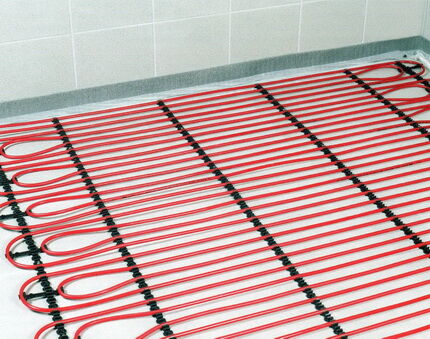
Rod heating mats do not have this drawback. They are pairs of conductors connected by parallel rods.
The system operates on the principle of self-regulation of the degree of heating. Heated floors of any type are equipped with a thermostat, which controls the heating of the device to a certain temperature, after which the equipment turns off.
Periodic automatic switching on of the system is carried out only in order to maintain the set temperature. This mode of operation allows you to save energy, but such heating is still quite energy-consuming.
Therefore, it is often used as an additional heating system and for arranging especially comfortable warm zones in rooms. This could be, for example, areas for children's games or the floor in the bathroom.
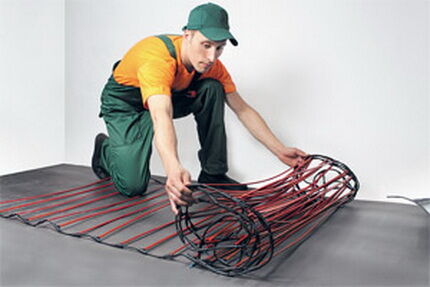
Types of electric heated floors used in everyday life are given here. For those wishing to compare different system options and evaluate their pros and cons, we advise you to familiarize yourself with the contents of this article.
Conclusions and useful video on the topic
The video review will tell you which electric boiler to choose for your home:
Let's look at the features of different types of electric heated floors:
How infrared heating works:
Oil radiators, electric heaters and similar equipment can be classified as “yesterday”. It is almost impossible to organize full heating with their help. In addition, they are very uneconomical, so electricity bills will be simply astronomical.
The electric heating systems discussed above are effective and can be used for private homes. It is only important to insulate the building well, otherwise you will have to pay too much for electricity.
What type of electric heating systems do you use to improve comfortable conditions in your home? Perhaps you know the useful subtleties of choosing and operating heating electrical equipment? Please write comments, leave photos related to the topic of the article, and ask questions in the block below.




We have electric heating in our cottage; in fact, a lot of money is spent on heating the room, so we carefully insulated the house in order to economically use the energy spent on operating the boiler and circulation pump. It’s still not cheap, but this method of heating a cottage is much safer, so you have to sacrifice something. I'm glad that the costs are not constant, but only in cold weather.
I have long wanted electric heating for my dacha. After all, I work in the field related to ecology, this is important to me. Electrical systems do not harm the environment, which is good news) Moreover, the equipment is considered safe, since it does not work with explosive substances. I read more information on this topic and realized that I definitely need to install it without hesitation.
Olga! Electricity (in the long term) is the future. A small correction - green electricity (not obtained from the combustion of gas - “gas”). Therefore, the strategic direction of electric heating of the home (and obtaining hot water) is correct! When it comes to sustainability...you'll be right on your side when green electricity is used. Gas electricity is produced with an efficiency factor of 0.35, that is, there are still harmful emissions, they just are not in your home, but at a thermal power plant. This future will also bring closer the emergence of capacious, reliable, durable and relatively inexpensive electric batteries. Water heat accumulators are still widely used.
Warm floors are the simplest and most practical option, in my opinion. The country house itself is furnished exactly this way. At home they are heated by radiators, but there, in a wooden house, there is no such luxury :) I heard about infrared heating that there is a risk of cancer, I don’t know how true this is, but I was wary... special thanks for the video, very informative.
Gena, with oncology - don’t even think about it! Infrared radiation is long waves longer than visible light. They are emitted, with varying degrees of intensity, by any hot object.
Hello. Infrared irradiation is in no way associated with the appearance of oncology. Moreover, it is widely used in medicine in physiotherapeutic procedures. Some clinics even practice treating cancer tumors with infrared radiation.
Good day. In the section about heating elements there is this phrase: “As a result, the efficiency of each such heater is no more than 80.” Very curious - what happens to the remaining 20 percent? What are they spent on?
Here I have a heating element in series with a TV fuel boiler. "Just in case". By the way, covered with thermal insulation. Power - 4 kW. From the logic of the article, when it is turned on, almost a kilowatt of power is consumed in an unknown direction. Excuse me, where? To swing a spherical horse in a vacuum?
In the video “the operating principle of infrared heating,” the girl says that 1. when heated by batteries, the temperature at the floor is 18 degrees, and at the ceiling 35 degrees. In principle (with very high ceilings) this is probably true. But I doubt that this is the case in most cases. In an ordinary apartment in a multi-storey building, the temperature of the floor and ceiling differs by 2-4 degrees. 2. There are also doubts that this difference will be eliminated (reduced) by battery-free (floor) heating or infrared heating. After all, according to the laws of physics, heated air rises anyway. Another thing is that with infrared heating, the air is not heated directly, but indirectly - the air from heated solid objects. I’m not against it, but I’m in favor of infrared heating, it’s just that in the video these inaccuracies “hurt the ear.”